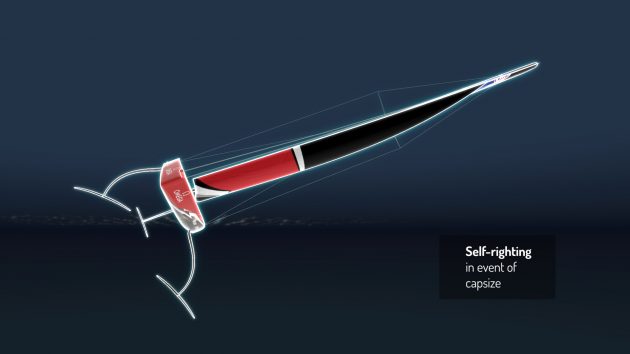Emirates Team New Zealand has unveiled the new AC75 monohull for the next America's Cup and this incredible new flying monohull could be faster than the AC50 catamarans
One of the fastest and most futuristic sailing designs in history has been unveiled by Emirates Team New Zealand (ETNZ) and challenger of record Luna Rossa as the class for the next America’s Cup in 2021.
The new AC75 will be a fully flying monohull. Instead of a keel, it has two canting, ballasted T-foils to provide righting moment and the ability to self-right the boat in the event of a capsize. Like the catamarans of the last Cup, it will be able tack and gybe on foils.
Early computer modelling suggests it could be even faster than the AC50 catamarans and look even more spectacular.

It marries some of the best features of the multihulls, such as high speed and design innovation, to traditional monohull sailing action and manoeuvres. The new design will be raced by 12 sailors and the animation suggests a return to traditional grinders (no more ‘cyclors’?). The new design may have a wingmast and soft sails including a Code 0 for light winds crossovers.
As the video released by ETNZ shows, this is unlike any boat previously seen. Watch this video to see how it will work.
The new design is the result of four months working through different concepts, led by ETNZ’s design co-ordinator, Dan Bernasconi. The eventual design was always going to be a monohull because that is what ETNZ had agreed Luna Rossa in exchange for funding and design tools that assisted their victory in Bermuda.
“We are really proud to present the concept of the AC75…Our analysis of the performance of the foiling monohulls tells us that once the boat is up and foiling, the boat has the potential to be faster than an AC50 both upwind and downwind. Auckland is in for a highly competitive summer of racing in 2020/2021,” said ETNZ’s CEO, Grant Dalton.
The only other fully funded and confirmed team for 2021, Ben Ainslie’s Land Rover BAR, was not consulted about the design choice, but were given a heads-up in recent weeks. The team’s new CEO, Grant Simmer, who most recently worked with Oracle Team USA, says: “I think we were surprised that they went for such a bold solution, but we applaud it. It’s a strong technical challenge but a good call and in the spirit of the Cup.”
But he says that campaigns will not be less expensive. “We anticipate that they will actually be more expensive,” comments Simmer. With most of the money being spent on development and salaries, and the sailing teams increasing to supply a race crew of 12 people, Cup teams might spent even more than the €100 million-plus that they each laid out for Bermuda.
But one-design elements of the class have been promised, which might make it easier for new and first-time teams to form for the next America’s Cup and still be competitive. ETNZ is to announce the full class rule details next March but has already indicated that the hydraulics, batteries and control hardware for the foils, for example, could be one-design, with scope for development of control system software.

ETNZ has also said specifically that fully autonomous autopilot systems for controlling the position of the foils will not be allowed. Key controls such as the flaps of the T foils and their cant position will have to be adjusted manually by crews.
The foils will enter the hull topsides and go through a wet box area, where they will be operated by hydraulic rams that move then in and out and from vertical to horizontal position. On a traditional monohull the keel attachment is the area of highest load, but here it will be these foil attachments.
Choosing a rotating wingmast and soft sails rather than a wingsail that needs to be craned on board each time the yacht races is pointed to as having more ‘trickledown’ potential for other areas of sailing. But the decision has also been taken because once these boats are foiling, the restrictions on speed come from either foil cavitation or aero drag, and designers believe that it will be easier to manipulate a soft wingsail to reduce drag.


Although not offshore yachts, they will also be able to race in a wider variety of sea conditions, including the choppy wind over tide conditions seen in the Takapuna area of the Hauraki Gulf. Experts believe that it might be possible to control ride height sufficiently to race, fully foiling, in waves of around 1m.
If designing and building such futuristic boats is a huge set of challenges, so will racing these beasts. “We are in the early days of modelling, but there will be big changes in righting moment so manoeuvring will be incredibly challenging,” observes Grant Simmer. The new design promises to open up another immense new chapter in foil development and sailing technique.




